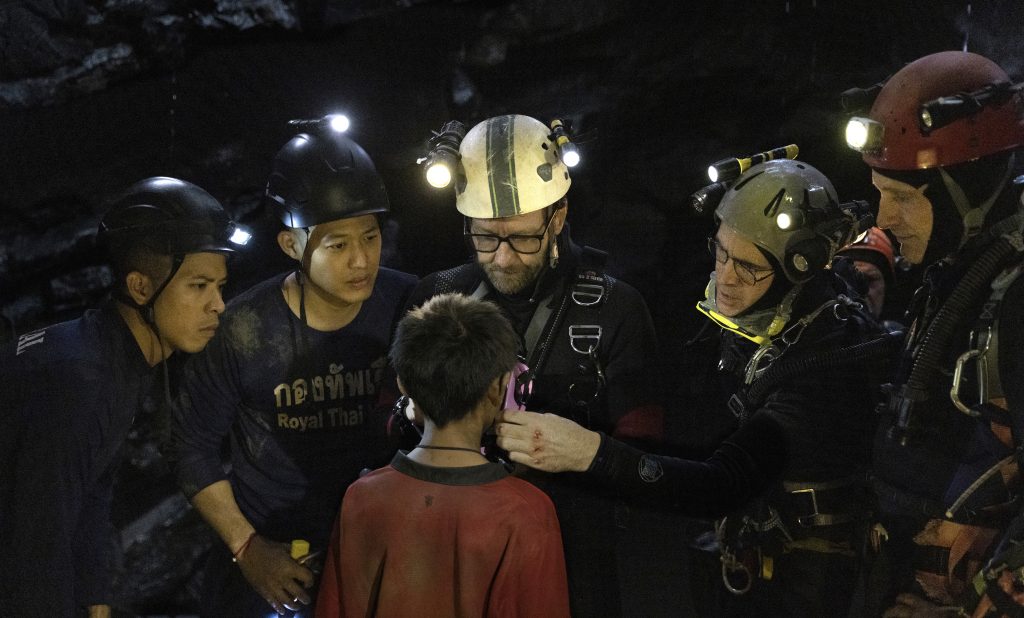The story, if any of us remember it, goes like this: On June 23, 2018, 13 boys in Northern Thailand bicycled to a nearby cave system before a sudden monsoon-induced flood blocked their way out. The 12 soccer players, ages 11 to 16, and their coach were trapped on a ledge several miles deep inside the labyrinth of flooded tunnels.
It took 10 days just to locate the boys, and several more to rescue them through a concerted effort involving more than 10,000 volunteers from all over the world.
Of course, such an uplifting story was always destined for Hollywood. This month, “Thirteen Lives” was released on Amazon Prime Video. Directed by Ron Howard, the result is a film that succeeds largely because of what it doesn’t do.
For example: Disaster movies based on real events often overplay their hand when it comes to conveying pathos. Instead, Howard opts for a narrative that is fast, sober, almost documentary-like: “I wanted to be as journalistic about the story as I possibly could be,” said Howard ahead of the film’s Aug. 5 release.
“Thirteen Lives” doesn’t spend time giving background on the kids or their families. There is minimal information about the rescuers, and the film’s characters don’t develop much. Drama is kept to a minimum: There is no dwelling on the anguish of the trapped kids or their parents. There are no long emotional speeches, no sentimental side plots. The story’s emotional climax, the reunion of the children with their parents, is dealt with in 15 seconds.
This makes for extremely effective storytelling. A lesser artist would have played up and lingered on the story’s emotional turning points. In “Thirteen Lives,” things just happen and they happen more quickly than one would expect.
The film’s creators made another important creative decision: to not idealize the story’s heroes.
“There is a certain ‘non-heroic-ness’ to the rescuers,” said actor Paul Gleeson, who plays rescuer Jason Mallinson. “If you met Harry or John or Rick on the street, you likely wouldn’t say, ‘Oh, those guys saved children from an underwater cave.’ ”
Viggo Mortensen plays Rick Stanton, the gruff, no-nonsense British cave diver who first finds the kids and later comes up with the bold plan that saves them. Rick is not a hero by vocation: he is a man, with a specific set of skills, who responds to a call.
They are creative decisions that make the story beautiful, and even greater than its subject matter. A story is “true” not because it is a faithful account of something that really happened, but because its artistic coherence turns it into a distillate of great truths.
That belief was shared by the great Catholic writer J.R.R. Tolkien, who wrote to his friend W.H. Auden in 1955 that “if one makes a good choice in what is ‘good narrative’ … at a given point, it will also be found to be the case that the event described will be the most ‘significant.’ ”
Paradoxically, Tolkien also believed the more factual and accurate a well-told story is, the more it lends itself to becoming a symbol, or an allegory.
What is the allegory of “Thirteen Lives”? For me, it is that of the only, ever recurring true story: the story of God’s intervention in history through his Son and through his Church.
Many of us will have felt like the kids portrayed in “Thirteen Lives” at least once in our lives. Like Dante at the beginning of “The Divine Comedy,” we have also wandered into a dark place. We found ourselves trapped on a narrow ledge, suffocating and unable to get back to light, joy, meaning. The oxygen level drops a little every day, and the water level rises.
Yet when all hope seems lost, a rescuer arrives. A savior descends into the cave to save us, motivated only by love. As the governor says of the volunteers who collaborated in the rescue in the film, “You asked nothing in return. You did all this for one reason, for love of the boys.”
It’s the kind of rescue operation one can experience in the Church, which, like the rescuers in the movie, is composed of men and women who look nothing like heroes. The reluctant savior, the grumpy, ordinary messenger whom an invisible hand put in charge of descending into the depth to save us: is not this a perfect image of the Church?
“Thirteen Lives” reminded me of the time I found myself at the bottom of such an existential cave. It was the winter of 2005, and I still perfectly remember the face of the unassuming hero who came to look for me, the man who emerged out of the water, the one whom God tasked with the salvific mission of Christ. He was a real human being, and he dragged me along a narrow tunnel, a path marked by a red line, a way that led me back to life and to love.
This is how I experienced the Church; it is this experience that made me a Christian. I lived it again as I watched “Thirteen Lives.”

